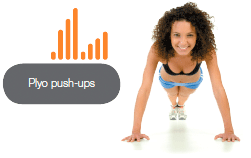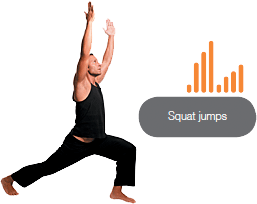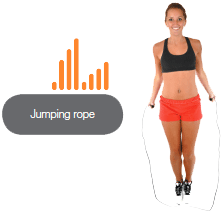Phase 1
Exercise 1: Jump or hop onto a box, bench or platform. We are looking for a "quiet" landing and a landing position that is not deeper than a half-squat position.
The height of the box can be anywhere from 4 to 24 inches - challenge yourself!
Exercise 2: Drop-jump from a box, bench or platform. Athletes need to land safely after being airborne, using the largest possible surface area of the foot by landing on their toes before softly rolling down on their heels. This prevents damaging any of the joints and in particular twisting the knee. The knees have a tendency to move inward when jumping off a box onto the floor. This inward movement of the knees has a high risk of injury. Concentrate on landing with the patella (knee cap) over the second toe.
 Exercise 3: Bunny jumps - start with your feet just beyond shoulder-width apart. Bend your knees to a three-quarter squat position and swing your arms back and past your hips. Drive your legs explosively upward to lift your body from the ground and jump forward. Keep your trunk upright during flight. Extend your legs in front of your body to get your feet out in front of you. Land on the balls of your feet and spring into another jump.
Exercise 3: Bunny jumps - start with your feet just beyond shoulder-width apart. Bend your knees to a three-quarter squat position and swing your arms back and past your hips. Drive your legs explosively upward to lift your body from the ground and jump forward. Keep your trunk upright during flight. Extend your legs in front of your body to get your feet out in front of you. Land on the balls of your feet and spring into another jump.
Phase 2
Exercise 1: Use a hurdle or object ranging in height from 12 to 30 inches. The idea is to jump over the hurdle with a quiet, stable landing.
Exercise 2: One-leg hurdle hop and stick. Running is a one-leg activity, with full body weight and impact forces being absorbed by one leg at a time, not two. Most athletes begin plyometric programs with two-leg drop-jumping and build up significant coordination and strength with the technique before moving on to one-leg dropping.
 Phase 3
Phase 3
Exercise 1: Start out with side-to-side jumps; eventually progress to starting out on the right leg and bouncing to the left leg. Stand with your feet just beyond shoulder-width apart. Slightly bend your knees, extend your legs and leap to one side. Land with your feet just beyond shoulder-width apart and on the balls of your feet. Immediately react to the ground and jump to the other side (use a relatively low trajectory). Land and jump back across to the other side. Keep your trunk upright and look straight ahead of you.
Be consistent with your training - for plyometrics, that means two days a week. You are also advised to take long rests between sets, especially at the beginning, and always stop at the first signs of fatigue and injury. Diversify the routine and train on your feet, moving in multi-directions, it burns serious calories and allows you to work on movements - and parts of your body - that you may not have used in a long time. As always, talk to your doctor before beginning any new exercise program, particularly if you haven't been active lately and/or you have a health condition that could affect safe performance of the above exercises.
 Common Plyometric Exercises
Common Plyometric Exercises
- Jumping rope
- Jumping jacks
- Squat jumps
- Lunge hops
- Skater plyos (bounding to the left and right, imitating a skating motion)
- Overhead medicine ball tosses
- Medicine ball chest passes
- Plyo floor push-ups (push-ups that involve quick upward acceleration with your hands actually leaving the floor during the upward movement)
- Medicine ball abdominal twist and throw
Note: For detailed instructions on how to perform some of these exercises, see the "Your Beginning Plyometric Program" section.
Jeffrey Tucker, DC, is a doctor of chiropractic and rehabilitation specialist who integrates chiropractic, exercise and nutrition into his practice in West Los Angeles. You can sign up for his newsletter at DrJeffreyTucker.com.

